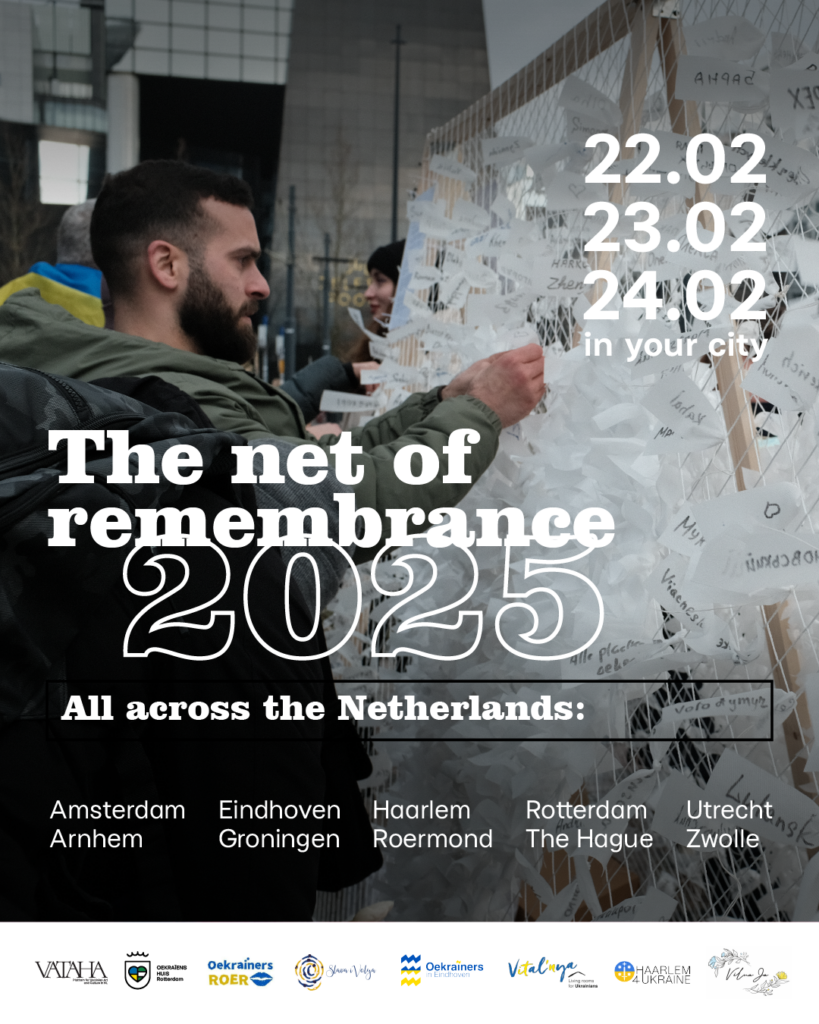During this year’s third anniversary weekend of russia’s full-scale invasion of Ukraine, ten Dutch cities participated in VATAHA’s Nets of Remembrance. The 2-by-2-meter art installation invites local residents and passerbys to write the name of a lost loved one onto a strip of white fabric and weave it onto the net.
This installation has become somewhat of a VATAHA tradition — having been featured at last year’s Run for Ukraine and commemoration of the 2nd anniversary of russia’s invasion of Ukraine — and serves as a humble means of processing grief and loss through art and community action.

Such a simple action can have a tremendous impact on those with broken hearts, some more recent than others. We asked the organizers of eight participating cities’ Net of Remembrance to recall the atmosphere at their installation, and why it resonated so strongly within the Ukrainian community.
Amsterdam | Nataliia Frolova | 70-100 participants
We chose a non-invasive approach [not to invite people directly to participate], since the Net requires more personal space for thoughts and emotions. Ukrainians knew what to do, even those who hadn’t heard the announcement from the stage, with just a brief look at the names on the stripes, unfortunately, could tell what this Net means.
One person comes to mind, a woman who had a whole journey with this net. First she was trying to approach it and left crying. The second time she tried to write a name, but couldn’t bear it and left. The third time she took a few stripes and started writing names, tied them and left crying. The fourth time she came with a journalist and was telling about people on the stripes, showing and touching them carefully.
The Net of Remembrance allows us to see that people like this woman are not alone in our loss. It allows us to face our grief.
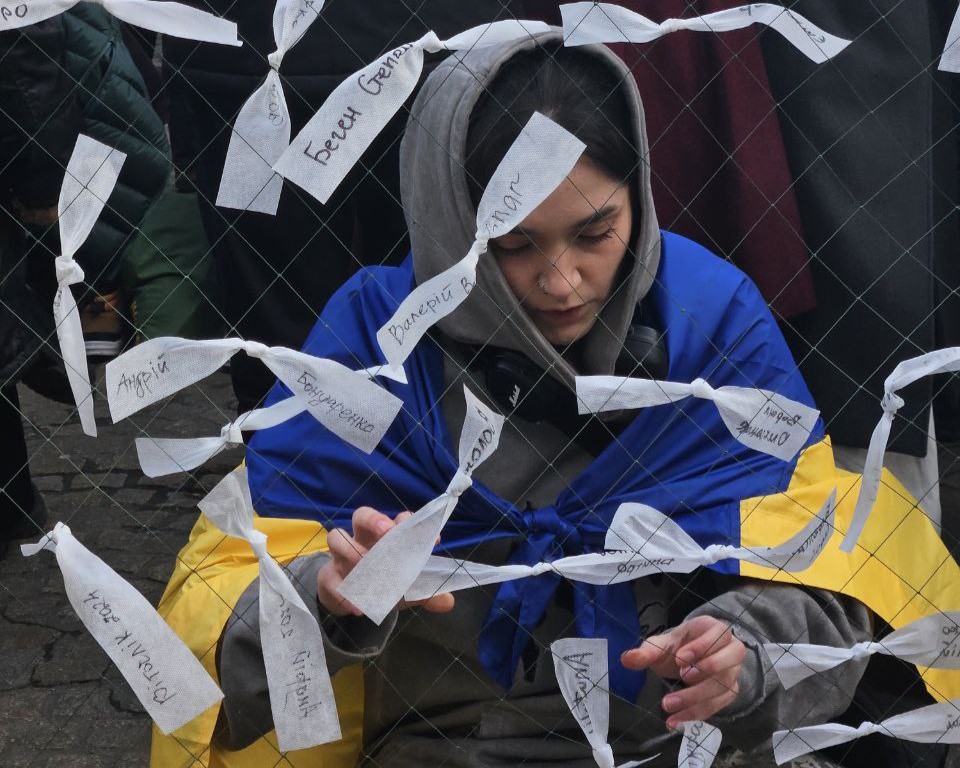
Haarlem | Nataliia Frolova | 10 participants
We brought the Net of Remembrance from Amsterdam and exhibited it at the Haarlem train station, allowing Dutch people to look and connect to the grief of people that live nearby, maybe just next door, and are affected by the war in Ukraine. We were mostly aiming for Dutch people, so we told them our stories.
I think it brings more understanding of displaced Ukrainians to locals and shows that we are still going through painful experiences every day.
Eindhoven | Nataliya Lushnikova | 200 attendees, 100-120 participants
This is an action of unity: quiet, painful, but also bright. It was the first time I organized something like this here and I was amazed by the number of people and the support of Ukrainians, Dutch people and foreigners. Many people said that it was good that without making speeches, everyone, if they wanted, was silent about their own [loss], or could speak about their own [pain].
I wrote the names of cousins from Rivne, my hometown, who died last year within a few months of each other: Mykola Silko, who died in February, and Kostyantyn Yuzvyuk in July. Kostya was a volunteer at the Maidan in 2014, then an animal rights activist. I was at his funeral in July last year, where his mother read his will. It impressed me so much that I ran for Kostya at the Run for Ukraine in The Hague, and we are in contact with his mother.
I was amazed by the number of people and the support of Ukrainians, Dutch people and foreigners.
Nataliya Lushikova
There was a woman from Kherson who tied several ribbons for people close to her who died in Kherson. Since someone from her family had recently died, I did not feel comfortable asking [her about it]. I talked to a guy who ran from a Hema shop nearby, he was in his work uniform during a short break. He turned out to be from Odesa. When I asked if he would like a ribbon and a marker, he refused, saying it was very difficult.
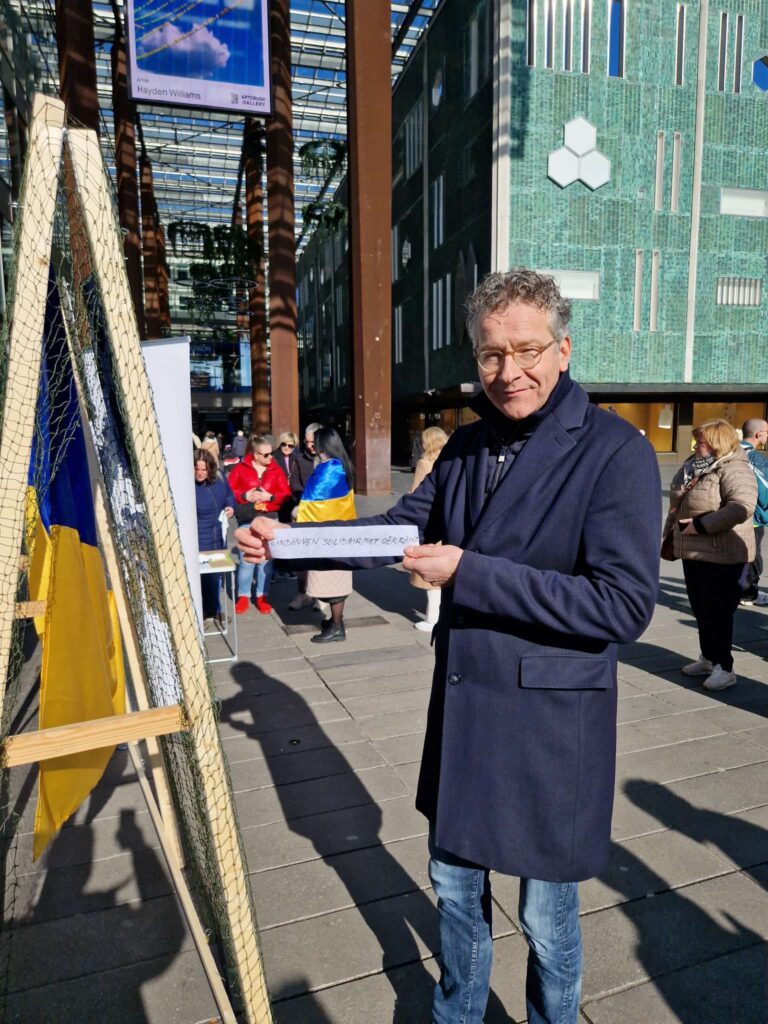
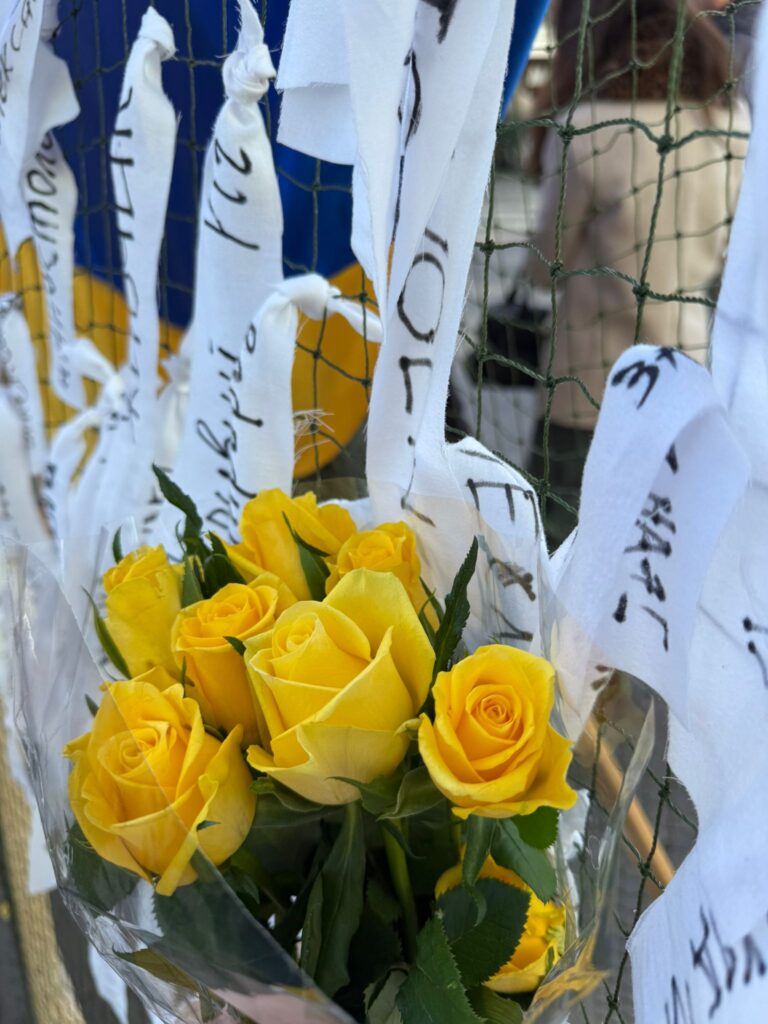
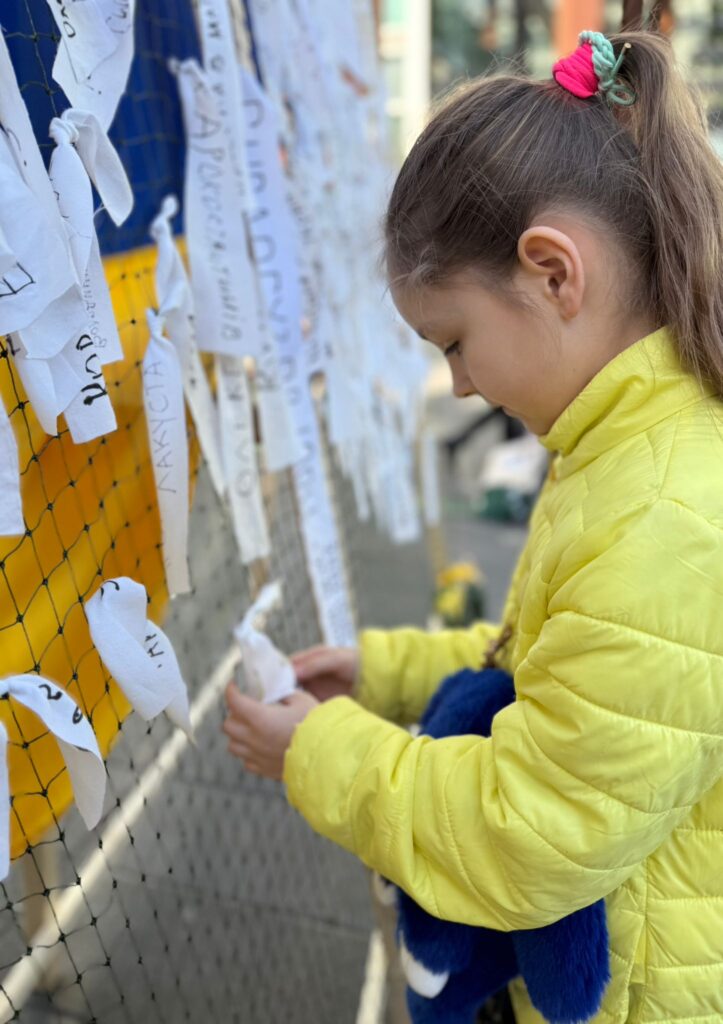
The Mayor of Eindhoven came to personally add his ribbon labeled “Eindhoven in solidarity with Ukraine.”
Groningen | Yevgeniia Aliksiuk | 50 participants
A little girl wrote the word “папа” [the russian word for “dad”] on her ribbon and such inscriptions are living history. Children wrote the names of animals they lost due to the war, the locals wrote the names of their loved ones. There should be a place where they can be remembered, where they can share what hurts.
The Hague | Olena Didkivska and Vlada Voskobiinyk | 20-30 participants
At this time and in this context, there wasn’t much that people chose to share. I assume that is because the setting was very public. However, it is always touching when people take many pieces of fabric to write names on, and when people cry when listening to the idea of the project. It is important to remind others about the very personal losses that this war has brought and how many there are. It also makes us feel more seen when we share it with others.
It was not the stories that moved me but the emotions I saw on the participants’ faces. The Net of Remembrance helped them to face the emotions and grief that they have inside. It helped them feel that they are not alone. It helped that their personal story is recognized.
It was not the stories that moved me but the emotions I saw on the participants’ faces.
Olena Didkivska
Arnhem | Oksana Patsyuk | Up to 50 participants
Some people just stood near the Net of Remembrance with tears in their eyes, but did not dare to approach it. There was one girl who silently wrote the word “TATO” [another Ukrainian word for “dad”] on a piece of paper in large letters.
This installation is particularly important for displaced persons because it gives them the opportunity to openly express their grief, honor the memory of their dead, and feel the support of the community that shares their pain.
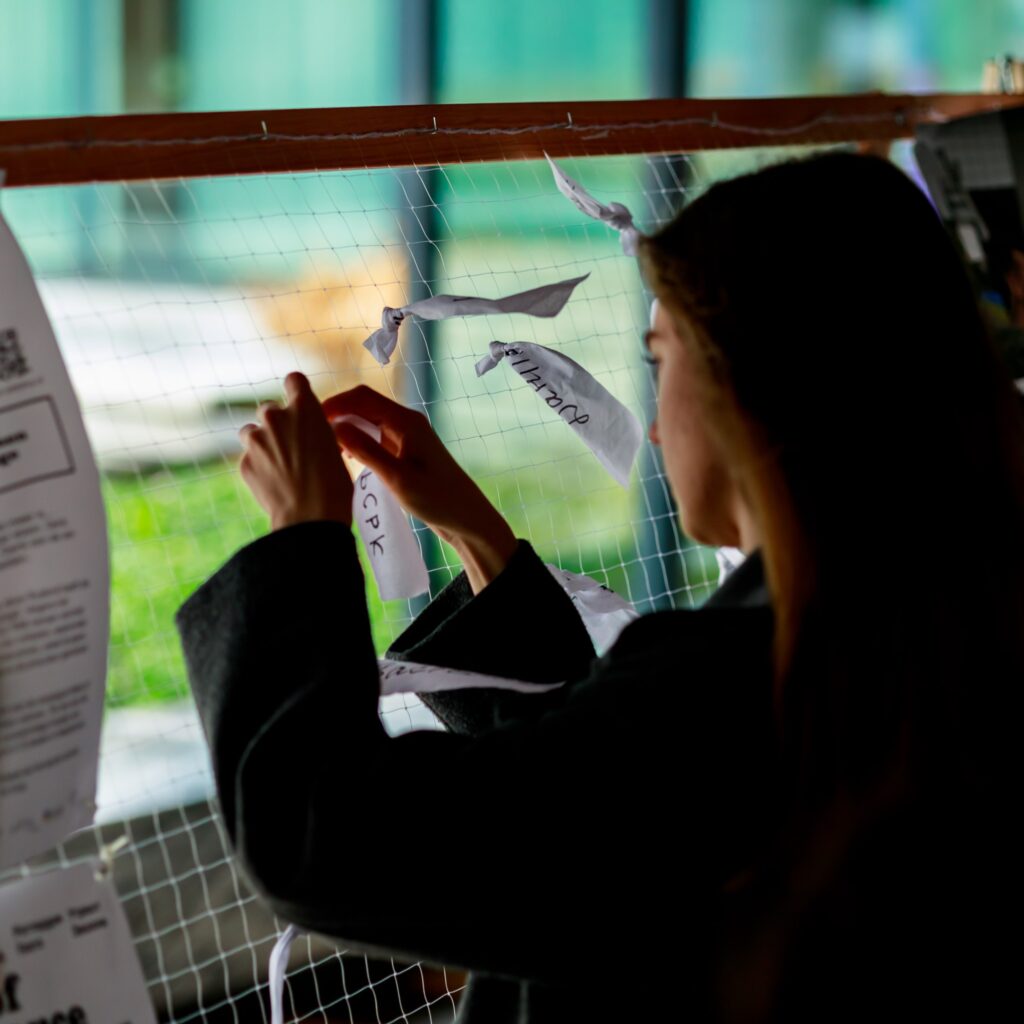
Roermond | Hanna Zhykhareva-Tolstik | 37 participants
A woman named Victoria wrote the city of Slovyansk on the ribbon. She tied the ribbon onto the Net, wept, and said that for her the war began in her native Slovyansk when tanks came there. It was very touching.
A Polish woman also came and asked to remember the names of two combat medics who had died, Valentina and Irina. She heard it on TV and cried a lot. She tied ribbons in their memory, and we cried together.
Another woman wrote the name of Maxim Semenov, the President of the Dnipro Cycling Federation, who died defending Avdiivka. She told me a lot about the festivals he organized for young people, how much he still could have done.
Every day we live with terrible news, we cry alone, but here we could cry together. This is a kind of healing.
Hanna Zhykhareva-Tolstik
Such installation is a very important form of drawing public attention to the war in Ukraine. This is especially important for Ukrainians who now live in the Netherlands. Every day we live with terrible news, we cry alone, but here we could cry together. This is a kind of healing. We heard many words of gratitude from the Ukrainians of Roermond.
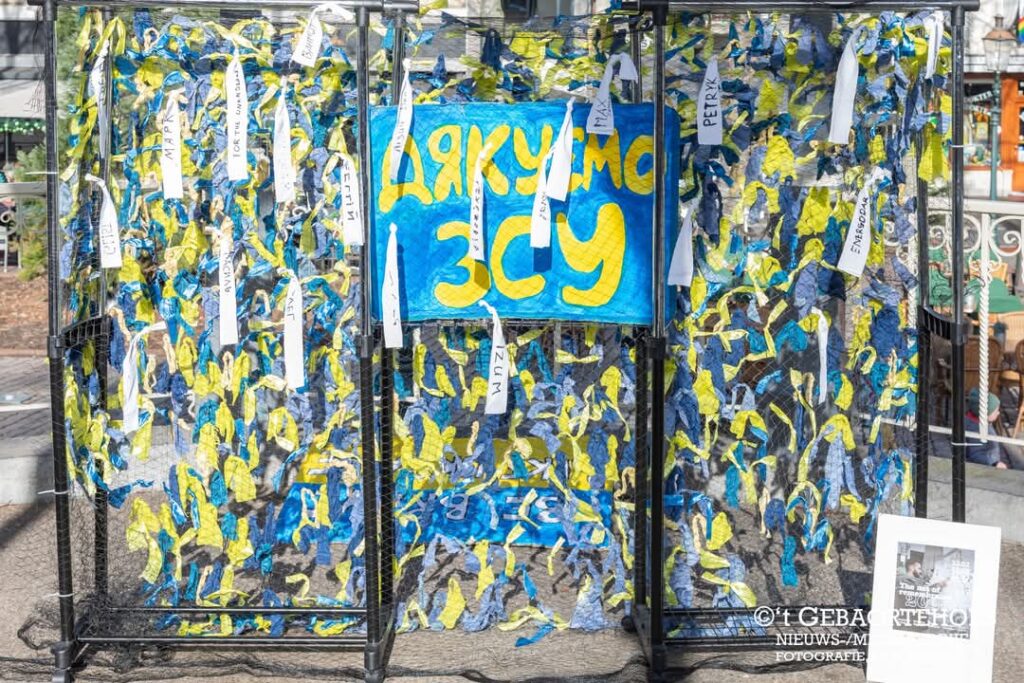
with the yellow and blue ribbons from the Net of Freedom.
Rotterdam | Uliana Bun | 7 participants
An elderly Dutch woman tied the name of a relative who died in 2014-2015 in a temporarily occupied city. There was also a story of a person who managed to leave the war, but this stress contributed to their death. This story also reflects how many people have lost someone not directly due to military aggressions, but still consider these losses to be related to the war.
I think the Net of Remembrance is an acknowledgement of the pain that many people carry. Despite the constant presence of war in each of our lives, we do not often talk about what hurts us the most. It is a way to remember people, but also a way to share our grief with others who are experiencing the same thing.
